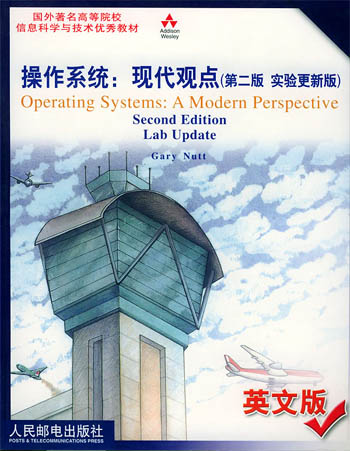
包邮操作系统:现代观点:第2版:实验更新版:英文版
国外著名高等院校信息科学与技术优秀教材

- ISBN:7115103445
- 装帧:简裝本
- 册数:暂无
- 重量:暂无
- 开本:16开
- 页数:679
- 出版时间:2002-08-01
- 条形码:9787115103444 ; 978-7-115-10344-4
内容简介
本书是一本操作系统课程的学习教材,全书共分十八章。**至第四章是介绍性内容,是学习操作系统的基础,其中**章介绍操作系统是什么和操作系统是如何发展到今天的现状的;第二章介绍如何使用操作系统,特别是多进程操作系统;第三章介绍操作系统的基本组织和实现策略;第四章介绍计算机的组织。从第五章开始介绍了操作系统的各个部分,首先在第五章介绍设备管理,特别是基本技术、缓冲区和设备驱动。第六章至第十章介绍进程管理,其中第六章介绍基本的任务概念、进程组织和资源管理;第七章介绍进程调度;第八章介绍基本的同步方法;第九章介绍高层的同步方法;第十章介绍死锁问题。在第十一章介绍了内存管理,第十二章介绍虚拟内存管理,第十三章介绍文件管理,第十四章介绍保护机制和安全策略。第十五章至十七章介绍了支持分布式计算的操作系统技术,其中第十五章介绍网络管理;第十六章介绍远程文件管理;第十七章介绍分布计算,包括分布式进程管理、消息传递机制、远程过程调用和分布式内存管理。*后在第十八章介绍了一些操作系统实例,包括UNIX、Linux、Windows NT、Mac OS和Chorus微内核操作系统。
本书是作为计算机科学和工程类专业教材编写的,也可供有关科技人员参考。
目录
To the Student 1
To the Instructor 6
Chapter1 Introduction 1
1.1 Computers and Software 2
1.1.1 General System Software 2
1.1.2 Resource Abstraction 4
* IN THE HANGAR: A Disk Device Abstraction 5
1.1.3 Resource Sharing 6
1.1.4 Computers Without System Software 7
1.2 Operating System Strategies 8
* PERFORMANCE TUNING: Multiprogramming Systems 10
1.2.1 Batch Systems 10
* IN THE HANGAR: Batch Files 13
1.2.2 Timesharing Systems 14
1.2.3 Personal Computers and Workstations 16
1.2.4 Process Control and Real-time Systems 18
1.2.5 Networks 19
1.2.6 The Genesis of Modern Operating Systems 20
* IN THE HANGAR: The Evolution of Linux 21
* IN THE HANGAR: The Microsoft Windows Family of Operating Systems 23
1.3 Summary 25
1.4 Exercises 26
Chapter2 Using The Operating System 29
2.1 The Abstract Model of Computing 30
2.2 Resources 30
2.2.1 Files 30
* IN THE HANGAR: POSIX Files 31
* IN THE HANGAR: Windows Files 33
2.2.2 Other Resources 36
2.3 Processes 37
2.3.1 Creating Processes 39
* IN THE HANGAR: Using FORK, JOIN, and QUIT 40
* IN THE HANGAR: Creating Processes in UNIX 41
* IN THE HANGAR: Creating Processes in Windows 44
2.4 Threads 46
* IN THE HANGAR: C Threads 48
2.5 Objects 49
2.6 Summary 50
2.7 Exercises 50
* LABORATORY EXERCISE: A Shell Program 53
·Background 53
·Attacking the Problem 58
* LABORATORY EXERCISE: A Multithreaded Windows Console Application 61
·Background 61
·Attacking the Problem 65
Chapter3 Operating System Organization 71
3.1 Factors in OS Design 72
3.1.1 Performance 72
3.1.2 Protection and Security 73
3.1.3 Correctness 74
3.1.4 Maintainability 74
3.1.5 Commercial Influence on Operating Systems 74
3.1.6 Standards and Open Systems 75
3.2 Basic Functions 76
3.2.1 Device Management 77
3.2.2 Process and Resource Management 77
3.2.3 Memory Management 78
3.2.4 File Management 78
3.2.5 Functional Organization 79
3.3 Basic Implementation Considerations 80
3.3.1 Processor Modes 80
3.3.2 Kernels 81
3.3.3 Requesting Services from the Operating Systems 82
3.4 Summary 83
3.5 Exercises 84
Chapter4 Computer Organization 85
4.1 The von Neumann Architecture 86
4.2 The Central Processing Unit 88
4.2.1 The Arithmetical-Logical Unit 88
4.2.2 The Control Unit 89
4.3 Memory 91
* PERFORMANCE TUNING: Speeding up the Machine 92
* PERFORMANCE TUNING: Parallel Processors 94
4.4 Devices 95
4.4.1 General Device Characteristics 96
4.4.2 Device Controllers 97
* IN THE HANGAR: Asynchronous Serial Devices 98
4.4.3 Device Drivers 99
4.5 Interrupts 100
4.6 The Mode Bit Revisited: The Trap Instruction 103
4.7 Summary 104
4.8 Exercises 105
* LABORATORY EXERCISE: Kernel Timers 109
·Background 109
·Attacking the Problem 113
Chapter5 Device Management 119
5.1 Device Management Approaches 120
5.1.1 I/O System Organization 120
5.1.2 Direct I/O with Polling 121
5.1.3 Interrupt-driven I/O 123
* PERFORMANCE TUNING: Interrupts Versus Polling 126
5.1.4 Memory-mapped I/O 127
5.1.5 Direct Memory Access 128
* PERFORMANCE TUNING: I/O-Processor Overlap 129
5.2 Buffering 130
5.3 Device Drivers 134
5.3.1 The Device Driver Interface 134
5.3.2 CPU-device Interactions 137
5.3.3 I/O Optimization 138
5.4 Some Device Management Scenarios 138
5.4.1 Serial Communications 138
* IN THE HANGAR: UNIX Device Drivers 139
5.4.2 Sequentially Accessed Storage Devices 141
5.4.3 Randomly Accessed Devices 142
* PERFORMANCE TUNING: Optimizing Access on Rotating Devices 144
5.5 Summary 149
5.6 Exercises 150
* LABORATORY EXERCISE: A Floppy Disk Driver 153
·Background 154
·Attacking the Problem 158
Chapter6 Process Management 161
6.1 The System View of Process and Resources 162
6.1.1 Implementing the Process Model 163
6.1.2 Imp
-

硅谷之火-人与计算机的未来
¥15.5¥39.8 -

人工智能的底层逻辑
¥55.3¥79.0 -

软件定义网络(SDN)技术与应用
¥26.9¥39.8 -

专业导演教你拍好短视频
¥13.8¥39.9 -

数学之美
¥41.0¥69.0 -

谁说菜鸟不会数据分析(入门篇)(第4版)
¥43.8¥69.0 -

自己动手写PYTHON虚拟机
¥35.0¥79.0 -

Photoshop平面设计实用教程
¥14.5¥39.8 -

计算机网络技术
¥13.9¥33.0 -

Excel函数.公式与图表
¥16.4¥48.0 -

.NET安全攻防指南(下册)
¥89.0¥129.0 -

.NET安全攻防指南(上册)
¥89.0¥129.0 -

大模型实战:微调、优化与私有化部署
¥64.4¥99.0 -

剪映AI
¥56.4¥88.0 -

FINAL CUT短视频剪辑零基础一本通
¥28.9¥39.8 -

数据挖掘技术与应用
¥46.0¥75.0 -

AIGC绘画CHATGPT+MIDJOURNEY+NIJIJOURNEY ――成为商业AI设计师
¥75.6¥108.0 -

计算
¥92.2¥128.0 -

智能化时代的舆论危机新应对
¥43.3¥58.0 -

MIDJOURNEY AI绘画从入门到精通
¥71.5¥98.0













